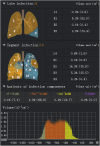Correlation between lung infection severity and clinical laboratory indicators in patients with COVID-19: a cross-sectional study based on machine learning
- PMID: 33602128
- PMCID: PMC7891484
- DOI: 10.1186/s12879-021-05839-9
Correlation between lung infection severity and clinical laboratory indicators in patients with COVID-19: a cross-sectional study based on machine learning
Abstract
Background: Coronavirus disease 2019 (COVID-19) has caused a global pandemic that has raised worldwide concern. This study aims to investigate the correlation between the extent of lung infection and relevant clinical laboratory testing indicators in COVID-19 and to analyse its underlying mechanism.
Methods: Chest high-resolution computer tomography (CT) images and laboratory examination data of 31 patients with COVID-19 were extracted, and the lesion areas in CT images were quantitatively segmented and calculated using a deep learning (DL) system. A cross-sectional study method was carried out to explore the differences among the proportions of lung lobe infection and to correlate the percentage of infection (POI) of the whole lung in all patients with clinical laboratory examination values.
Results: No significant difference in the proportion of infection was noted among various lung lobes (P > 0.05). The POI of total lung was negatively correlated with the peripheral blood lymphocyte percentage (L%) (r = - 0.633, P < 0.001) and lymphocyte (LY) count (r = - 0.555, P = 0.001) but positively correlated with the neutrophil percentage (N%) (r = 0.565, P = 0.001). Otherwise, the POI was not significantly correlated with the peripheral blood white blood cell (WBC) count, monocyte percentage (M%) or haemoglobin (HGB) content. In some patients, as the infection progressed, the L% and LY count decreased progressively accompanied by a continuous increase in the N%.
Conclusions: Lung lesions in COVID-19 patients are significantly correlated with the peripheral blood lymphocyte and neutrophil levels, both of which could serve as prognostic indicators that provide warning implications, and contribute to clinical interventions in patients.
Keywords: Artificial intelligence; COVID-19; Deep learning; Infection severity; Lymphocyte; Neutrophil; SARS-CoV-2.
Conflict of interest statement
The authors declare that they have no competing interests.
Figures




Similar articles
-
Diagnostic value of peripheral hematologic markers for coronavirus disease 2019 (COVID-19): A multicenter, cross-sectional study.J Clin Lab Anal. 2020 Oct;34(10):e23475. doi: 10.1002/jcla.23475. Epub 2020 Jul 17. J Clin Lab Anal. 2020. PMID: 32681559 Free PMC article.
-
CT Quantitative Analysis and Its Relationship with Clinical Features for Assessing the Severity of Patients with COVID-19.Korean J Radiol. 2020 Jul;21(7):859-868. doi: 10.3348/kjr.2020.0293. Korean J Radiol. 2020. PMID: 32524786 Free PMC article.
-
Analysis of clinical features and imaging signs of COVID-19 with the assistance of artificial intelligence.Eur Rev Med Pharmacol Sci. 2020 Aug;24(15):8210-8218. doi: 10.26355/eurrev_202008_22510. Eur Rev Med Pharmacol Sci. 2020. PMID: 32767351
-
Correlations of Clinical and Laboratory Characteristics of COVID-19: A Systematic Review and Meta-Analysis.Int J Environ Res Public Health. 2020 Jul 13;17(14):5026. doi: 10.3390/ijerph17145026. Int J Environ Res Public Health. 2020. PMID: 32668763 Free PMC article.
-
Thoracic imaging tests for the diagnosis of COVID-19.Cochrane Database Syst Rev. 2020 Sep 30;9:CD013639. doi: 10.1002/14651858.CD013639.pub2. Cochrane Database Syst Rev. 2020. Update in: Cochrane Database Syst Rev. 2020 Nov 26;11:CD013639. doi: 10.1002/14651858.CD013639.pub3. PMID: 32997361 Updated.
Cited by
-
Machine Learning and Lean Six Sigma to Assess How COVID-19 Has Changed the Patient Management of the Complex Operative Unit of Neurology and Stroke Unit: A Single Center Study.Int J Environ Res Public Health. 2022 Apr 26;19(9):5215. doi: 10.3390/ijerph19095215. Int J Environ Res Public Health. 2022. PMID: 35564627 Free PMC article.
-
Two Years after the Beginning of COVID-19: Comparing Families Who Had or Did not Have Patients with COVID-19 on Health Beliefs and Obsessive-Compulsive Symptoms.Iran J Psychiatry. 2023 Oct;18(4):429-442. doi: 10.18502/ijps.v18i4.13630. Iran J Psychiatry. 2023. PMID: 37881416 Free PMC article.
-
Screening and assessment for post-acute COVID-19 syndrome (PACS), guidance by personal pilots and support with individual digital trainings within intersectoral care: a study protocol of a randomized controlled trial.BMC Infect Dis. 2022 Aug 15;22(1):693. doi: 10.1186/s12879-022-07584-z. BMC Infect Dis. 2022. PMID: 35971066 Free PMC article.
-
Application of Machine Learning and Deep Learning Techniques for COVID-19 Screening Using Radiological Imaging: A Comprehensive Review.SN Comput Sci. 2023;4(1):65. doi: 10.1007/s42979-022-01464-8. Epub 2022 Nov 24. SN Comput Sci. 2023. PMID: 36467853 Free PMC article.
-
Artificial Intelligence in Surveillance, Diagnosis, Drug Discovery and Vaccine Development against COVID-19.Pathogens. 2021 Aug 18;10(8):1048. doi: 10.3390/pathogens10081048. Pathogens. 2021. PMID: 34451513 Free PMC article. Review.
References
-
- World Health Organization. Coronavirus disease (COVID-19) pandemic.2020. Available from: https://www.who.int/emergencies/diseases/novel-coronavirus-2019. Accessed 15 Mar 2020.
MeSH terms
LinkOut - more resources
Full Text Sources
Other Literature Sources
Medical
Miscellaneous

